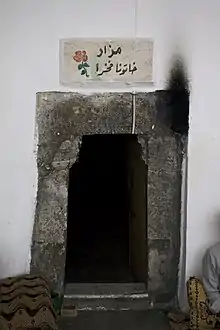Social organization of the Yazidis
There is a social organizational structure in the Yazidi community. There are three main castes, namely the Mirids, the Sheikhs and the Pirs. Furthermore, there are positions for dignitaries in the Yazidi hierarchy.
Mîr
The leader of the Yazidi is a hereditary Mîr or prince, and the current emir is Hazim Tahsin or Naif Dawud.[1] Hazim Tahsin is a former deputy in Iraq's Kurdish parliament.[1] The former head was his father, Tahseen Said, who died in January 2019 in Germany, and who was head of the community for nearly 75 years.[1] He is the supreme ruler over the Yazidi. He can expel anyone who opposes to his decisions from the community.[2] The family of the Mîr resides in Ba'adra.[3]
Baba Sheikh
The Baba Sheikh is the leader of all Sheikhs and the Kocheks. His post is mainly granted hereditary but he is appointed from the Mîr. He is obliged to observe long periods of fasting of 40 days in the summer and winter.[3] The acting Baba Sheikh has to be from the family of the Shemsani Sheiks.[4] He shall not be dismissed, and only be replaced if he dies or abandons the Yazidi faith.[5] The current Sheikh is Ali Alyas.[6] The previous sheikh was Khurto Hajji Ismail.[7]
Sheikh
All Yazidi are obliged to have a Sheikh and a Pîr. A Sheikh can express sermons and impose taboos on his followers (Mîrids). The Sheikh should attends important events like births, deaths and weddings. For this duty they give him a certain annual amount of money.[8] Sheikh has the same signification in Arabic like Pîr in Kurdish.[9]
Pîr
The Pîrs duties are similar to the ones of a Sheikh, he can attend the majority of the events as well which the Sheikh attends, if the Sheikh is not able to, but he is awarded just about half of the money a Sheikh receives in exchange.[10][9]
Peshimam
He is responsible to hold weddings ceremonies and is appointed by the Mîr amongst the family of the Peshimams. Also he can not be dismissed and only be replaced in case of his passing away or him abandoning the Yazidi faith.[5]
Kochek
The Kocheks are led by the Baba Sheikh and are the servants to Sheikh Adi. They collect wood and water among other duties they have. They are also known to observe long fasts and to be able to communicate with the "World of the Unseen".[11]
Fakra
_at_the_Yezidi_New_Year_festival_at_Lalish_(18_April_2017)_12.jpg.webp)
As Fakra (other spellings: Fekra, Fekhra, Fakhra, Fahra) the members of a Yazidi women's order are called. Only Yazidi women who are virgins and who have chosen a chaste and ascetic life can be accepted as members of this women's order. The Fakra are responsible for the maintenance of the Yazidi temple Lalish. Kebanî ("mistress of the house") is called the head of the Yazidi women's order.[12]
Kebani
Kebani ("mistress of the house") are members of a Yazidi women's order in Lalish who hold the highest position within the women's order. Kebani is the highest female rank within the Yazidi hierarchy that a woman can achieve. The rank is determined by the most deserving order members.[12][15]
References
- "Yezidis divided on spiritual leader's successor elect rival Mir".
- Lescot, Roger (1975). Enquête sur les Yézidis de Syrie et du Djebel Sindjâr. Beirut: Librairie du Liban. p. 85.
- Kreyenbroek, Philip G.; Rashow, Khalil Jindy; Jindī, Khalīl (2005). God and Sheikh Adi are Perfect: Sacred Poems and Religious Narratives from the Yezidi Tradition. Wiesbaden: Otto Harrassowitz Verlag. p. 10. ISBN 978-3-447-05300-6.
- Kreyenbroek, Philip G. (1995). Yezidism: Its Background, Observances, and Textual tradition. Lewiston, NY: E. Mellen Press. p. 127. ISBN 0773490043.
- Edmonds, C. J. (2002-03-21). A Pilgrimage to Lalish. Psychology Press. p. 26. ISBN 978-0-947593-28-5.
- "Yazidis appoint new spiritual leader in Iraq". 18 November 2020.
- Welle (www.dw.com), Deutsche (29 January 2019). "Yazidis mourn after Mir Tahseen Said Beg dies in Germany". DW.COM. Retrieved 7 June 2019.
- Kreyenbroek, Philip G. (1995). Yezidism: Its Background, Observances, and Textual tradition. Lewiston, NY: E. Mellen Press. pp. 129–131. ISBN 0773490043.
- Lescot, Roger (1975). Enquête sur les Yézidis de Syrie et du Djebel Sindjâr. Beirut: Librairie du Liban. pp. 90–91.
- Kreyenbroek, Philip G. (1995). Yezidism: Its Background, Observances, and Textual tradition. Lewiston, NY: E. Mellen Press. p. 131. ISBN 0773490043.
- Kreyenbroek, Philip G. (1995). Yezidism: Its Background, Observances, and Textual tradition. Lewiston, NY: E. Mellen Press. p. 134. ISBN 0773490043.
- Tagay, Sefik; Ortac, Serhat (2016). "Die Eziden und das Ezidentum – Geschichte und Gegenwart einer vom Untergang bedrohten Religion" (PDF) (in German). p. 72.
- Hassan Ahmed, Badeeah; Elizabeth McClelland, Susan (2020). "Eine Höhle in den Wolken: Dem IS entkommen" (PDF) (in German).
- Ahmed, Badeeah Hassan; McClelland, Susan Elizabeth (2020-09-14). Eine Höhle in den Wolken: Dem IS entkommen (in German). cbt Verlag. ISBN 978-3-641-25733-0.
- Baumann, Rüdeger (2020-02-27). Arbeitsbuch christlich-muslimischer Dialog: Orientierungshilfe und Handreichung (in German). BoD – Books on Demand. p. 30. ISBN 978-3-7494-7334-2.
